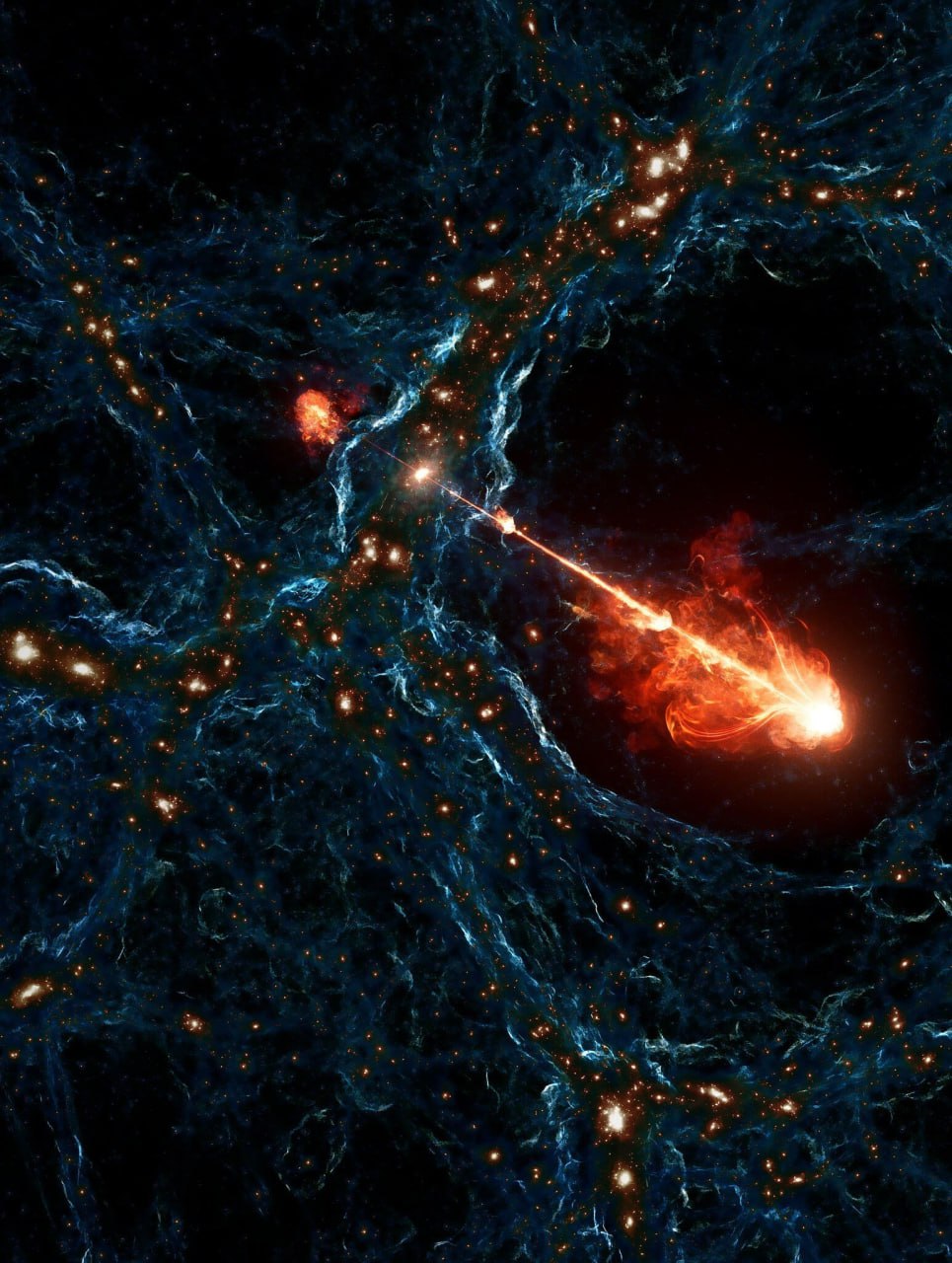This Black Hole Has a Cosmic Wingspan | Astronomers have discovered a black hole emitting energy in jets longer than the width of 140 Milky Way galaxies.
This Black Hole Has a Cosmic Wingspan
Astronomers have discovered a black hole emitting energy in jets longer than the width of 140 Milky Way galaxies.
Who knew a dragon’s tongue could be so long?
Astronomers announced last week that they had discovered a black hole spitting energy across 23 million light-years of intergalactic space. Two jets, shooting in opposite directions, compose the biggest lightning bolt ever seen in the sky — about 140 times as long as our own Milky Way galaxy is wide, and more than 10 times the distance from Earth to Andromeda, the nearest large spiral galaxy.
Follow-up observations with optical telescopes traced the eruption to a galaxy 7.5 billion light-years away that existed when the universe was less than half its current age of 14 billion years. At the heart of that galaxy was a black hole spewing energy equivalent to the output of more than a trillion stars.
“The Milky Way would be a little dot in these two giant eruptions,” said Martijn Oei, a postdoctoral researcher at the California Institute of Technology. Dr. Oei led the team that made the discovery, which was reported in Nature on Sept. 18 and announced on the journal’s cover with an illustration reminiscent of a “Star Wars” poster. The astronomers have named the black hole Porphyrion, after a giant in Greek mythology — a son of Gaia — who fought the gods and lost.
The discovery raises new questions of how such black holes could affect the evolution and structure of the universe.
“Astronomers believe that galaxies and their central black holes co-evolve, and one key aspect of this is that jets can spread huge amounts of energy that affect the growth of their host galaxies and other galaxies near them,” said S. George Djorgovski, an astronomer at Caltech who was part of the research team. “This discovery shows that their effects can extend much farther out than we thought.”
Astronomers are accustomed to seeing jets shooting from the centers of galaxies. But most jets do not extend beyond their host galaxy, Dr. Oei said.
“Porphyrion shows that small things and large things in the universe are intimately connected,” Dr. Oei added. If the jet was shrunk to the size of the Earth, the black hole would be just two-tenths of a millimeter across. “These giant jets are really incredible,” he said. “They are as if a single amoeba was able to generate two powerful streams of energy the size of Earth.”
Paradoxically, black holes — cosmic pits from which not even light can escape — can be the brightest objects in the universe. As anyone with a plunger knows, trying to force too much too fast down a drain can cause it to overflow, making a mess of the surroundings.
With a black hole, gas and other material gain energy as they are drawn into a hot disk swirling closely around its edge. Inward pressure from this accretion disk can squeeze some of the energy outward across space.
That’s what’s happening in the center of M87, a giant elliptical galaxy about 50 million light-years from Earth that has a spike of light shooting from its core. The galaxy harbors a black hole six billion times as massive as the sun. (In 2019, the Event Horizon Telescope captured the first-ever image of it.) But its jet extends for only about 100,000 light-years before dissolving into blobs of radio noise.


For the last few years, Dr. Oei and his team have been mapping the sky using a European network of radio antennas known as LOFAR, short for Low-Frequency Array. The team amassed an army of citizen scientists to help scrutinize the images. They weren’t looking for giant black-hole jets, but they found them anyway. “We had no idea that there were this many,” Dr. Oei said.
In 2022, the team announced that they had found a plume of plasma 16 million light-years long, roughly the width of 100 Milky Ways. They named it Alcyoneus, another ancient Greek giant that fought the gods (unsuccessfully) for supremacy over the cosmos. It was the record-holder until Porphyrion.
The bigger jet was first spotted by Aivin Gast, an Oxford student who joined Dr. Oei’s project after his studies in archaeology and ancient history were interrupted by the coronavirus pandemic.
“Aivin would create a list of jetty features in the radio sky, which I then checked and verified or discarded, with additional radio and optical data,” Dr. Oei said in an email. “After finding Porphyrion, we were both very excited, but it was initially ambiguous from which galaxy the jets really emerged.”
He added, “After the giant nature of the jets was finally confirmed, Aivin leveraged his classical background and proposed to give the system the beautiful name Porphyrion, which it now bears.”

The haunting question is what Porphyrion is doing to the rest of the universe. Cosmologists have found that the visible features of the universe are structured in a weblike manner, with galaxies clumped in giant clusters and connected by thin filaments that span dark voids of tens or even hundreds of millions of light-years. In Porphyrion’s day, this cosmic web was half the size it is now; such jets would have been big enough to affect the overall web, striking deep into the voids and depositing energy and heat there.
The energy from such jets, astronomers say, could have heated interstellar gas and prevented it from cooling and condensing into stars. Another possibility is that the jets are responsible for spreading magnetic fields into the voids. “The magnetism on our planet allows life to thrive, so we want to understand how it came to be,” Dr. Oei said.
The search continues for more giant jets. So far, after surveying about 15 percent of the sky, Dr. Oei’s project has found 8,000 jets longer than about three million light-years. By the time it is done, he said, his team might find as many as one million giant jets between Earth and Porphyrion.
“I think it’s quite clear that what we’re seeing is really just the tip of the iceberg,” he said.
A correction was made on Sept. 25, 2024:
An earlier version of this article misstated the approximate distance from Earth to the galaxy M87. It is 50 million light-years, not 50 billion light-years.



